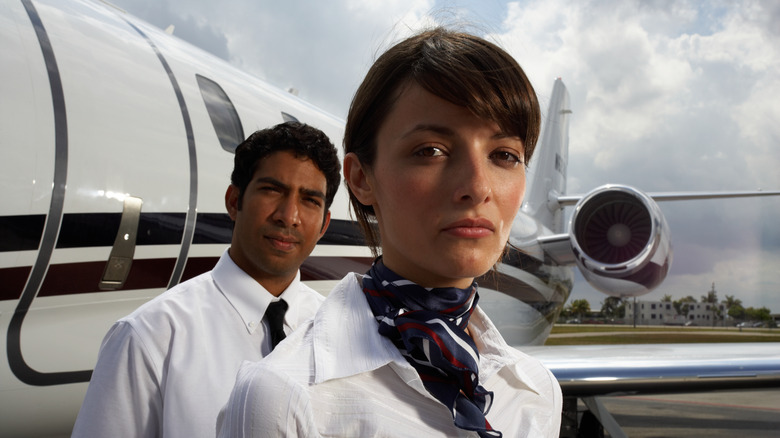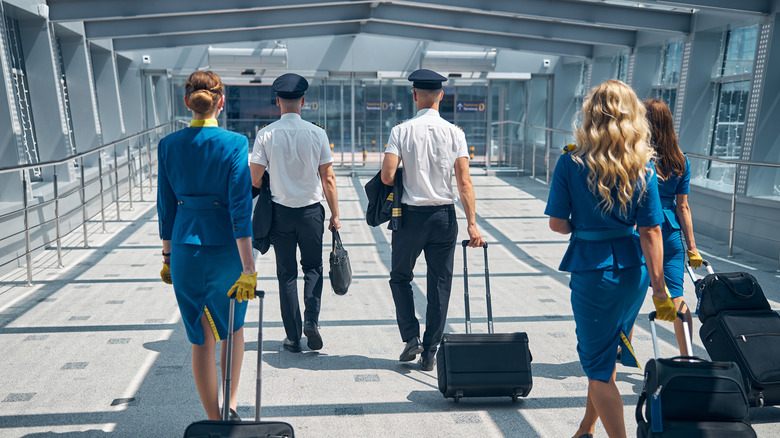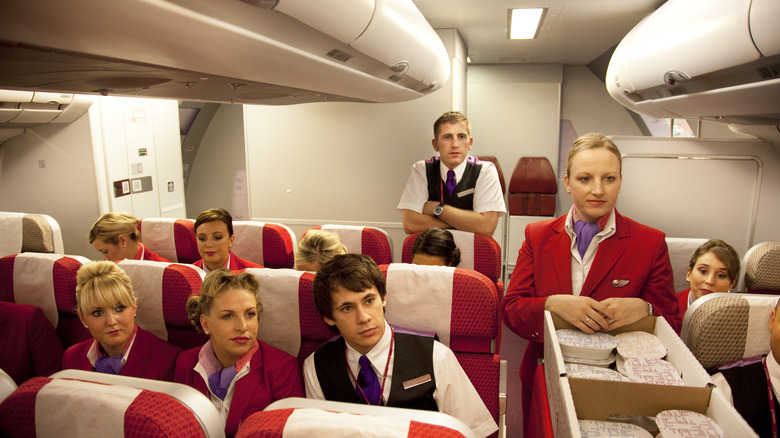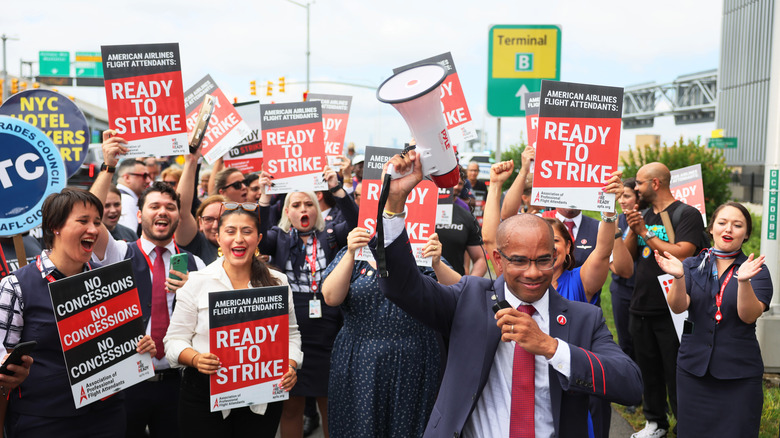The Sad Reality Of How Flight Attendants Are Actually Paid
Working as a flight attendant seems glamorous: traversing continents and oceans, wearing swanky uniforms, living a life of constant travel. To be paid for doing that? Even more glamorous! Flight attendants serve as the backbone of the aviation industry, ensuring passenger safety, comfort, and satisfaction. However, one thing your flight attendant won't tell you is that their salary doesn't always reflect the demands and responsibilities of the job. The sad reality of getting paid 36,000 feet in the air is much more complicated than it seems.
The payment structure for flight attendants is unlike that of many other professions, with a unique system that includes hourly pay, but only under certain conditions, along with various allowances and bonuses that can make their earnings appear more intricate and sometimes less substantial than they are. The most fundamental aspect of a flight attendant's pay that often leads to misconceptions is the concept of "flight time," which is delineated by "blocks."
Unlike the conventional 9-to-5, where employees are paid for being at work, flight attendants are paid only from the time when the aircraft door is sealed and the plane starts moving — which is termed "block out." All the time spent preparing the cabin, boarding passengers, stowing luggage in the overhead compartment, and waiting for the aircraft to take off is entirely unpaid. The second and final block is termed "block in." This is when the plane reaches the gate at its final destination and the parking brake is set, thus marking the end of "flight time."
Flight time, per diem, and seniority
In addition to the base pay for flight time, flight attendants receive a per diem, which averages between $1.50 to $2 for every hour spent away from their home base. This allowance is meant to help cover meals, basic essentials, or incidental expenses. It should be noted that airlines do pay for flight attendants' hotel rooms if they are on a layover. Lastly, miscellaneous bonuses: These include extra pay for flying to international destinations and additional compensation for working as a lead flight attendant or in-flight language interpreter.
In the life of a flight attendant, seniority is a key determining factor in several aspects of the job. It can influence pay, flight assignments, hotel check-in, cabin food choices, schedules, and even opportunities for promotion. Although this doesn't sound too unfair, it is very competitive — somebody is always looking to fly higher on that seniority scale over their coworkers, as it is the main way to advance in this career. Seniority is one of the annoying reasons this TikToker despised being a flight attendant.
Senior flight attendants (also known as senior cabin crew members) get first dibs on flight schedules — ideally, international flights that pay more and offer generous layovers, which can serve as a micro-vacation. Based on seniority, flight attendants can also receive about 10 to 20 days off per month. As a result, newer flight attendants are left with less desirable routes and sporadic schedules, often starting their careers on reserve status. This means no set schedule and having to be on-call (either at home or at the airport), with a window of just a few hours to report for duty.
Low salary and sky-high turnover
Considering all these pay structures and complicated variables, how much do flight attendants actually make? This varies by airline, experience, and seniority. On average, flight attendants earn approximately $67,000 annually. Entry-level positions may see earnings around $38,000, while the very few at the higher end can earn up to $97,000. Flight attendants work an average of 65 to 90 hours of "flight time" every month. They also work an additional 35 hours entirely unpaid (at least in Canada, per Canadian Union of Public Employees).
At this point, you may wonder how anyone even survives working this job. Unsurprisingly, flight attendant morale is at an all-time low, and the turnover rate is sky-high at 18%, according to a 2021 publication by the Embry-Riddle Aeronautical University. Before even putting on their official uniform, a quarter of candidates quit or cannot pass their flight attendant training. Once they do get their wings, only 50% survive their first year as a flight attendant. The sad reality is, indeed, far from glamorous.
Flight attendants have become increasingly vocal as they aim to raise awareness of these problems. Their primary concerns are regarding the compensation model: an unpredictable pay structure determined by their "flight time" without much regard for the physical and mental challenges imposed by the role. Because of these factors, flight attendants are taking action and protesting against those who do not adequately support them, including governments and corporations.
Strikes and unions for better flight attendant pay
The Worldwide Flight Attendant Day of Action took place on February 13, 2024. This historic event saw participation from over 100,000 flight attendants who held picket protests at more than 30 airports. Over two-thirds of U.S. flight attendants were engaged in contract negotiations at the time, including those from major airlines such as American, Alaska, and Omni. A statement by the Association of Professional Flight Attendants reads, "Our time on the job must be compensated. We need retirement security. We need flexibility and control of our lives."
Undeniably, the future of the aviation industry depends on its response. Several airlines, such as Southwest and United, have agreed to begin negotiations in hopes of reaching new and better working agreements. This is where unions come in to help facilitate the process and assert the rights of flight attendants. Unions are vital in mediating pay scales, supplying benefits, and ensuring healthy and ethical working conditions. However, progress can be slow, as increasing dissatisfaction brings more protests and labor disputes, further complicating flight attendants' financial stability.
According to the U.S. Bureau of Labor Statistics, the job outlook for flight attendants is expected to grow by 11% from 2022 to 2032, much faster than the average for all other occupations. To retain these future (and current) flight attendants and meet the travel-bug demand that's led to about 100,000 daily flights, it is essential to establish more supportive and financially viable working conditions. Hopefully, the sad reality of how flight attendants are actually paid has the potential to take off and become a lot more glamorous and rewarding.



